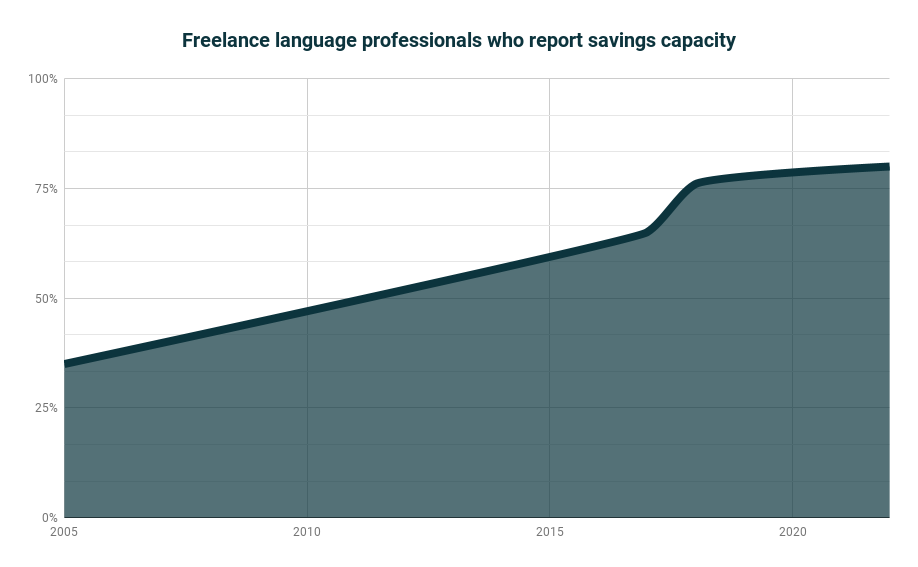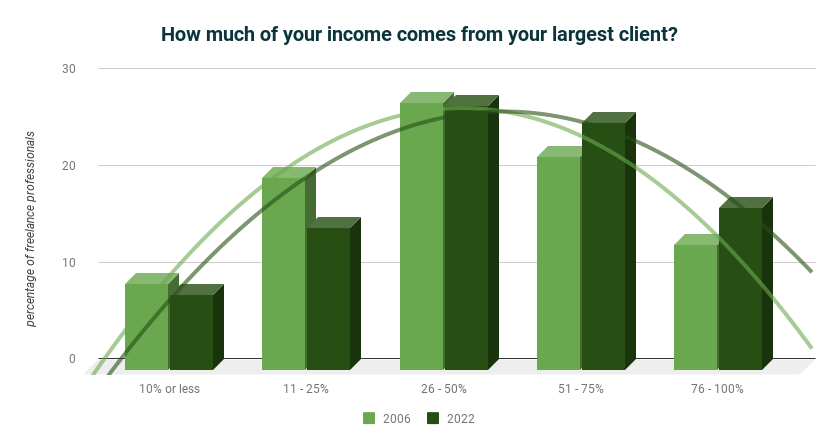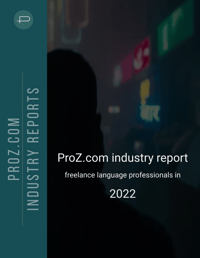To touch briefly on rates, we can say that in the two years prior to 2022, around 47% of freelance language professionals adjusted their rates upward, either partially or across the board. So far in 2022, 41% have either partially or completely adjusted their rates; another 14% are planning to do so, and 15% are still on the fence about what to do. How this looks in practice has many variations. Some maintain the rates they charge their longer-standing clients while introducing newer rates to new clients. Or perhaps they also raise the rates they charge their older clients, but much less sharply. Some analyze and make adjustments on a client-by-client basis, taking into account the relation that has been established, volume and frequency of the work, and even how interesting, fun, or challenging they find the work from a given client.
It is not the intention of this report to provide advice on what one should do with one’s rates. But here is some food for thought. In the context of what we have seen so far in this report, where demand for work is up, the demand for highly-skilled language professionals is up, spending on content and language services is either steady or up, and inflation and cost of living have been on the rise, one might say that there are indicators that if you have not analyzed your rates and considered the possibility of adjusting them accordingly in some time, now might be an appropriate moment. Waiting until the inflation storm has blown over and costs are no longer rising so sharply may leave one behind the curve on pricing, and making adjustments to bring one’s pricing up to date may become more difficult.
What about overall income?
52% of language professionals report that their overall income has increased over the past two to three years, while 19% say their overall income has decreased. It probably makes little sense to look at specific monetary amounts, since what those amounts mean from place to place and individual to individual will vary wildly. But about the same percentage, 53%, would rate their income as average or above average for the place where they live. 80% say their earnings are greater than the minimums established in their country of residence (usually a minimum monthly salary).

Depending on where you live, income may be less meaningful than savings capacity (the ability to set aside money and not spend it). Freelance language professionals are able to save more than in previous years. The percentage of professionals who report they are able to put some of their income into savings has steadily increased, from 35% in 2005, to 80% in 2022. Around 12% do not have any savings at the moment. This of course includes those who are just starting out, and may be a percentage that fluctuates with more ease than in other lines of work.
Savings capacity is important to any worker, but is more crucial to a freelancer than others, since they are generally more vulnerable to sudden gaps in incoming work and the income it represents. Not only are more freelance language professionals able to save, the amounts they are able to save have also increased in recent years. For example, in comparison with 2016, in 2022 the percentages of freelancers who have a “cushion” of mere weeks or a month of income have decreased, and more and more are able to build up enough to protect the regularity of their income for various months and even years.



We will look at some client-specific trends in a moment, but while we’re on the subject of income, relatively little has changed in the last ten years in regards to the proportions of income to number or type of client. For the most part, translators and interpreters manage to not put too many of their income eggs in one client basket, so to speak. There has been a slight increase in professionals who report that 75 - 100% of their income comes from their biggest client (13% in 2006, 17% in 2022), but the majority appear to be trending towards client rosters which are healthy enough that the sudden loss of their largest client would not adversely affect their income in the short term.
Due to the internationality of the work, language professionals’ incomes are also more susceptible to issues involving the exchange of currency. In 2022, 47% reported that currency conversion had a negative impact on their earnings to some degree.

Freelance language professionals have a lot going for them, and are above-average in many respects. Long-term planning, however, does not seem to be an inherent component of the average translator's or interpreter’s skill set. As with almost anything else, it can be learned, but it can be difficult to break away from the day-to-day, job-to-job, client-new-client perspective and cycle.
For example, freelancers have the luxury-curse of deciding when they will retire from professional activity. This can lead to some not making the decision at all until they can absolutely no longer avoid it, and more importantly, not planning for something like retirement. 55% have not made any retirement plans at all, and at least 25% report they have no intention of retiring.
Around 14% have a written business plan of some kind. Regarding the shorter term in business, when asked for plans on a yearly basis, only around 19% report formulating a plan for the year, at least mentally. For the most part, plans are either on a day-to-day basis, or a week or few in advance (77%).
This does not mean that the average freelance translator or interpreter is not thinking about the future of their business... they are just doing so... differently.
In the 2020 - 2022 period, language professionals were investing in their businesses on a greater scale than had been the trend pre-pandemic. Only 12% state they have made no monetary investments in their work and tools during this time. These investments include hardware, software, memberships and marketing efforts, training and industry events, and tools to improve administrative processes. 30% made investments in the range of 200 - 700 USD (or equivalent), roughly another 30% in the range of 700 - 2,000 USD (or equivalent), and just over 11% invested more than 2,000 USD (or equivalent).
36% of freelance language professionals put part of their income towards financial investments (including stocks, bonds, funds, real estate, etc.).
Continuing professional development (CPD) is an investment in one's business which also often has a price tag, so it is worth mentioning here. Just over 56% of language professionals did some form of continuing professional development between 2019 and the start of 2022. So far in 2022, 38% report doing "tracked" CPD; 20% are doing CPD but not keeping close track of what and when.





 Freelance language professionals have a lot going for them, and are above-average in many respects. Long-term planning, however, does not seem to be an inherent component of the average translator's or interpreter’s skill set. As with almost anything else, it can be learned, but it can be difficult to break away from the day-to-day, job-to-job, client-new-client perspective and cycle.
Freelance language professionals have a lot going for them, and are above-average in many respects. Long-term planning, however, does not seem to be an inherent component of the average translator's or interpreter’s skill set. As with almost anything else, it can be learned, but it can be difficult to break away from the day-to-day, job-to-job, client-new-client perspective and cycle.


